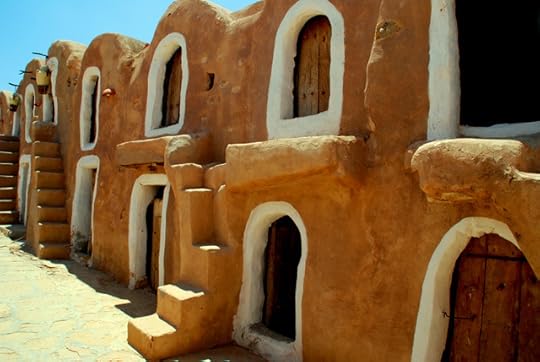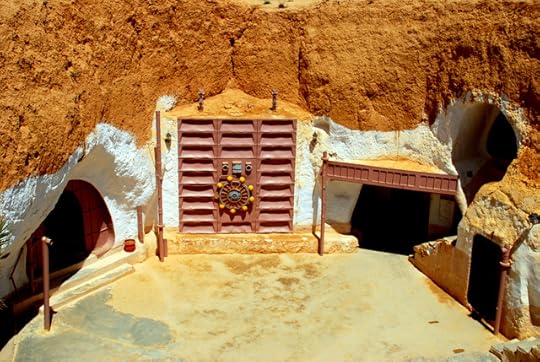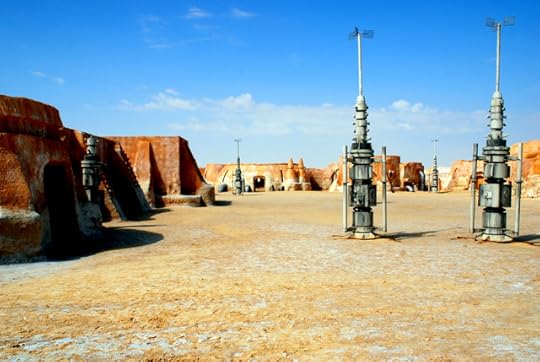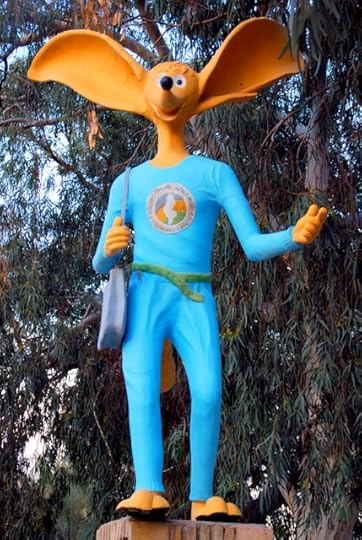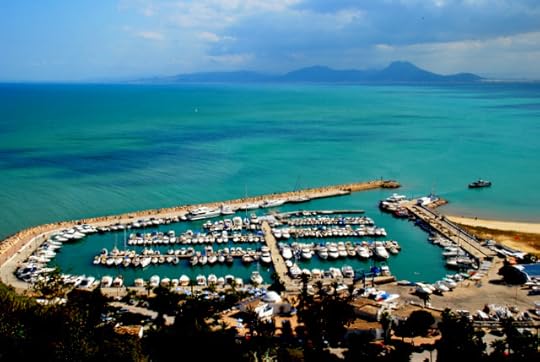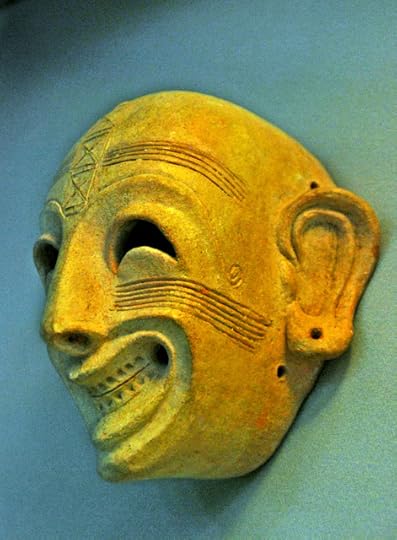Roderick Phillips's Blog, page 9
April 27, 2014
Ksar Hadada, Tunisia, Day 272
The one thing neither Christi nor I had expected to find in cave #17 of the Sidi Driss hotel was mosquitoes, but there was a bunch of the noisy little buggers last night. Fortunately, they stood out easily from the whitewashed walls and were easy prey for my weighty Lonely Planet guide to Africa. And as is usual in desert environs, it got darned chilly during the night and both Christi and I were scrambling to find extra blankets. Tour groups start arriving early at the Sidi Driss hotel and on our return from breakfast in the Star Wars courtyard we are surprised to find some Italian tourists follow us into our cave. And they didn’t seem to be in any rush to leave until Christi shooed them out of the way. In fact to escape the tourist bombardment yesterday we returned to the sunlight and explored more of Matmata, including a troglodyte lady who has lived underground her entire life. With no family to support her now she has opened her home to tourists. And not surprisingly she doesn’t seem very happy to have so many strangers tramping through the place. We also found a fixer, Ahmed, yesterday (Is every Arab man named Ahmed a fixer?). Or more accurately he found us and wanted to know our plans for the next few days. He offered to put a program together for us to visit a few interesting places. Naturally he wanted multi-days but we compromised on a day trip with an English-speaking guide. We try to cover all eventualities, because if it isn’t discussed and agreed upon ahead of time, then it is not and will never be a part of the program. And any time you want to change the program, you have to renegotiate the price. Arabs take this very seriously. We agree to visit a Berber village and two Ksars and then to be dropped off in the town of Medenine from where we can arrange onward transportation by louage. Sounds perfect. Well…
Our driver/guide is not the fixer so already there is some confusion with the program. The driver plays loud Arabic music, smokes continuously, insists on stopping at every retail opportunity, and completely ignores Christi and I. We do enjoy a pretty ride through the hills around Matmata, including a stop at the not quite Hollywood-famous sign for Matmata before reaching the first destination in our program: the Berber village of Toujene. Ahmed the fixer said it is more authentic than the more popularly visited village of Chenini. Toujene reminds me of the Berber villages Christi and I saw clinging to the slopes of the High Atlas Mountains. There are a lot of barking dogs in this village, which does make one wary of rabies (we say this after nibbling on bat in Kumasi, Ghana). The town is quite dilapidated or full of character depending on the spin you wish to apply; even the mosque has a wonky filial on its minaret.
Our guide is quite impatient and honks his horn after 30 minutes. We ignore it of course and continue poking around the Toujene. When we do eventually amble back to the car, our driver is apoplectic and tells us we must go more quickly otherwise we won’t have enough time to complete the program.
There are many Ksars around Tataouine, a couple of which were featured in the prequel movies, namely Ksar Hadada and Ksar Ouled Soltane. Ahmed said the latter was too far away to be included in this program and instead substituted the less commonly visited Ksar el-Hallouf. When we reach this first Ksar, our driver insists we only stay 15 minutes. This time I take umbrage and tell him in no uncertain terms that we will take as long as we want. I also tell him to turn off the music and to stop smoking while he is chauffeuring us around. I’m sure I’ve probably offended him because he walks away and ignores us.
Ksar el-Hallouf is certainly remote and its disused ghorfas (stacked cavities) are very photogenic against the backdrop of the dry, golden hills. Ksar means fortified village and it was that part of the community where the harvested grains, dates, figs etc. were stored (in the ghorfas). And since this food meant the difference between life and death, the ghorfas were well protected against theft from enemies. These Berber designs were so visually appealing that George Lucas used them as slave quarters in the prequel movies, particularly Ksar Hadada – our last stop on this abridged tour. This Ksar is the only location so far to openly acclaim its Star Wars association. Part of this Ksar is falling into ruin, but is fun to explore. There are three-story structures here, and each ghorfa is a large vaulted room. The other part of the complex is the Ksar Hadada hotel, which is where The Phantom Menace was actually shot. As with much else here in the desert, the hotel is falling into disrepair. It no longer offers accommodation, only restaurant facilities. Christi and I spend ages wandering through the narrow, low-ceiling passageways imagining we are part of the Star Wars universe. Fantastic.
Finally, the driver can whisk us away to Medenine and be rid of us; we are certainly glad to be rid of him. I think the only reason he did not dump us in the desert is that we hadn’t paid for the tour yet (130 Dinar [US$85]) The louage ride from Medenine to our next destination the port town of Houmt Souq on the island of Djerba (which is linked to the mainland by a long causeway) is a pleasant contrast to the frustrations of our tour.
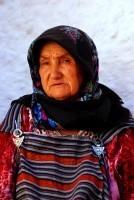

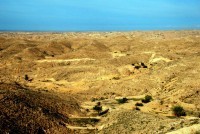
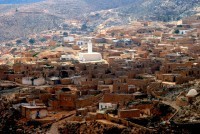
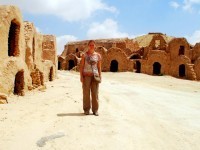
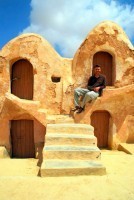
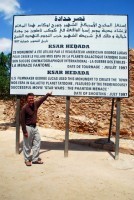
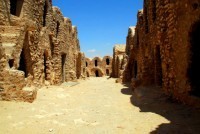
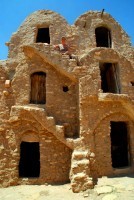
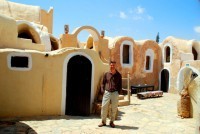
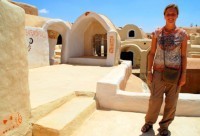

Blog post by Roderick Phillips, author of Weary Heart – a gut-wrenching tale of love and test tubes.
The post Ksar Hadada, Tunisia, Day 272 appeared first on Roderick Phillips.
April 26, 2014
Matmata, Tunisia, Day 271
There are several options for traveling around Tunisia, including train, bus, and louage. It seems as if every country in Africa has its own private competitor to the public transport system and in Tunisia it is the louage. As usual it only leaves when full, but unlike our previous misadventures with sept-places (Senegal) and grand-taxis (Morocco), the louage is the real deal: air-conditioned mini-vans where one person has a seat to themselves with 8 passengers maximum per vehicle. And unlike the public bus, which stops frequently, the louage is non-stop between destinations. In fact, as Christi and I plan our onward travel from Tozeur we are actively encouraged by the locals to use the louage because the minivans are faster and safer than the derelict public buses. That said our destination, the troglodyte town of Matmata, is not on any direct route. We have to do it stages, beginning with the 90 km crossing of a salt pan called Chott el-Jerid to the town of Qibili (5.5 Dinar [US$3.50]; 90 minutes). It rained during the night and the salt crystals are shimmering diamond bright. Barely do we have time to alight from the minivan when we’re bundled into the next louage for the 120 km (7 Dinar [US$4.50]; 120 minutes) journey to Gabes on the Mediterranean coast. The bus station into which we arrive in Gabes is not the same one from which connections to Matmata depart. We’re given vague directions. We hoist our packs onto our shoulders and trudge around repeatedly getting lost and having to stop strangers and ask in rudimentary French for directions. The correct bus station is more of a parking lot where louages stop to drop off and pick up passengers. This third minivan takes us 30 km closer to our destination (1.5 Dinar [US$1]; 30 minutes. Somewhat confusingly the town is called Matmata Nouvelle, which we are assured is not the right Matmata. That is a further 15 km away (2 Dinar [US$1.25]; 15 minutes. Our fourth louage brings us safely into Matmatat-Al-Qadimal (commonly known as Matmata) 250 km and 4 hours and 15 minutes after leaving Tozeur for about US$10 per person.
Matmata is a small, dusty town in southern Tunisia. It is home to a couple thousand souls who traditionally lived underground to avoid the oppressive heat. These people were called troglodytes (troglodyte means those living in caves). No doubt the locals were quite content to live their unique lifestyle in relative obscurity. But then Star Wars came along and things changed forever. George Lucas found the troglodyte way of life so unusual and out of this world that he featured it in his movie. Many people still choose to live in these caves, which are often extensive networks of tunnels and courtyards. Some of these dwellings have even been converted into hotels. Christi and I visit one of these (the Sidi Driss hotel), which is particularly famous because of its connection to Star Wars. The Sidi Driss hotel doubled as the Lars homestead on the desert planet of Tatooine (which is the fictional home of Luke Skywalker). Tatooine is actually another town in southern Tunisia, which does not appear in the movie, but George Lucas liked the name enough to immortalize it in his sci-fi epic.
The Sidi Driss hotel is very popular with day-tripping tourists. From 9 am to 5 pm the area in front of the cave entrance is a parking lot of tour buses. Despite this apparent popularity, though, only two people (bet you can’t guess who they are) elect to spend the night in their own private cave. Each cave is minimally appointed: there are three beds squeezed in and a single electric light bulb (not even a lampshade). As long as Christi and I are in the center of the cave we can just about stand upright; otherwise we have to stoop. There is, in case you are wondering about such practical matters, a separate ablutions block in one of the connecting tunnels. The block resembles a row of port-a-potties. (Note the courtyard in which we stay is one of five in the hotel, but is not the one used for filming Star Wars). After the crowds finally depart, it is wonderful to have these iconic surroundings to ourselves. Surprisingly the owners of the Sidi Driss hotel have let the place fall into disrepair (including the Star Wars set decoration), and once again there is not one single item of Star Wars memorabilia available (what is going on? How much power could George Lucas wield?)) The food and the service are not much to write home about, but the atmosphere is magical: eating dinner and staring up at a billion stars (And as far as I know George Lucas can’t charge you for looking at the stars – yet).
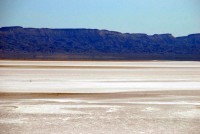
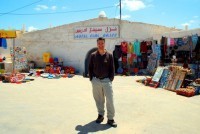

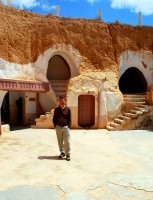
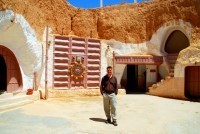
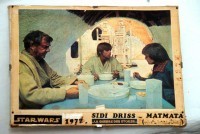
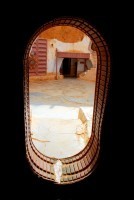
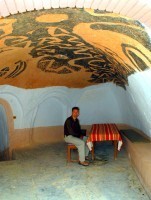
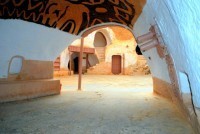
Blog post by Roderick Phillips, author of Weary Heart – a gut-wrenching tale of love and test tubes.
The post Matmata, Tunisia, Day 271 appeared first on Roderick Phillips.
April 25, 2014
Star Wars Country, Day 270
In 1978 when I was…well…a lot younger than I am now, growing up in the rural South-west of England was an idyllic if slightly dull experience. The nearest town of any size was Exeter, some 40 miles to the south-east, which was accessed via a tortuous, winding road where progress was often blighted by farm vehicles, herds of sheep and cattle, and floods. We took family trips to Exeter two to three times a year solely for the purpose of buying new clothes and always on a Saturday (how miserable), although one could argue that these fledgling adventures did stimulate in me a desire to experience a world outside my own narrow borders. London, however, remained an elusive dream while the USA might as well have been on a different planet. That said, the USA did influence my young life – partly through an upsurge in TV programming that beamed its way onto our flickering television sets, but mostly through the movies. And in 1978 rumours trickled down even to my rural little backwater that a new kind of movie was coming to town, the Avatar of its age.
I queued up with the other youngsters from our town and, having fought for my ticket, rushed to find the best seat in the theatre. And there I sat in the darkness waiting – wanting – to be spellbound. Eventually the screen curtains parted and the opening titles loomed large above me: ’A long time ago in a galaxy far, far away…’ they began. We were off: two hours (plus a 10 minute intermission to change the rolls of film) of action, adventure, and never before seen special effects. I emerged from the theatre desperate to be like Luke Skywalker, escaping my quiet existence and tackling the likes of Darth Vader and the evil Galactic Empire.
You may be wondering, dear reader, why this post begins with such a lazy stroll down memory lane? Well part of Star Wars was filmed in the desert around Tozeur. Clearly, I had to make the pilgrimage. The question is whether my visit would rekindle that childhood sense of wonder first awakened in me a long time ago in a movie theatre far, far away…
Tozeur is our first Star Wars hot spot. There are a few others, I just haven’t been brave enough to mention them to Christi yet. I say ‘our’ first hot spot, although it’s fair to say Christi does not really share my enthusiasm for this journey of re-discovery.
To back up for a moment, I had assumed on arrival in Tunisia that Star Wars would be an immense tourist draw. I actually spoke to the tour agencies in Tunis airport, but the agents merely shook their heads. I thought it must be a language issue, but sadly I was wrong. There is absolutely zero Star Wars merchandise available - not a T-shirt, mug, or even a postcard. Even if George Lucas (creator of the Star Wars franchise) has the worldwide merchandising rights to the six-movie saga sewn up, you can normally rely on the ingenuity of Africans to rip-off the official merchandise, but apparently not in this case.
Our hotel the Residence Warda in Tozeur does offer a Star Wars tour of sorts but they are vague on the details. I travel hopefully, but not confidently. We begin our mini Star Wars adventure at Chott Gharsa, where Chott means dried out salt lake. The salt lakes here are not as abundant in the condiment as the Salar de Uyuni; here it is more of a thin crust. It is, nonetheless, a beautiful vast nothingness framed by rich rust-colored sandstone hills,which the guide assures us featured in the movie. Our driver is very definitely not a guide, though. There is no rich back-story or insider gossip to set the scene and titillate the senses. Still he does try to show us a good time with some fancy off-road maneuvers, including driving up and down steep sand dunes and banking high on the slopes of the sandstone hills. And much like the southwest circuit of Bolivia there are numerous 4WD vehicles around us. This is something of a surprise since we saw very few tourists in town yesterday or on the train.
Finally we come upon the largely deserted film set of Mos Espa in Ong Jemel which features prominently in the first prequel, The Phantom Menace (apparently the Mos Eisley set from the original Star Wars movie has long since disappeared – mostly from souvenir hunters and the elements). The other tours stop for 5 minutes and are gone, leaving Christi and I to relive the magic of the Star Wars movies in peace. The village is based on classic Berber dwellings: dome-shaped mud structure, although there are some alien-like antennas, doors, and gizmos still in place. Low white dunes surround the set. It is easy to let my imagination run wild as we play with our pretend lightsabers (OK, I play and Christi rolls her eyes in disbelief). I tell Christi I can feel the Force within me and all around to which she quips, ‘Does the Force tell you that the tour guide wants to leave?’ I slink back to the vehicle, but inside my childlike sense of wonder has been wonderfully rekindled.
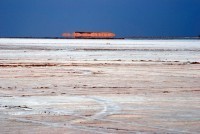
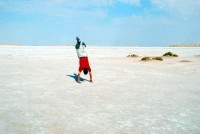
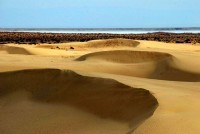

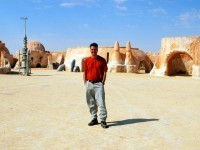

Blog post by Roderick Phillips, author of Weary Heart – a gut-wrenching tale of love and test tubes.
The post Star Wars Country, Day 270 appeared first on Roderick Phillips.
April 24, 2014
Tozeur, Tunisia, Day 269
After a brief exploration of Tunis, Christi and I are back on the trains today, and this time we’re riding the Tunisian rail network just about as far as you can go: from Tunis on the Mediterranean coast to Tozeur on the edge of the Sahara desert. Yet again we treat ourselves to a first-class ticket, but as the cost is only US$17 pp, it is well within budget. Train travel is clearly popular because the carriages are packed. Having said that all we see are locals, there are no tourists and no backpackers in sight. This appears to be a feature of Morocco, Tunisia (and from previous experience) Egypt. Most tourists arrive on organized tours and they all travel in private air-conditioned coaches. Backpackers are a rarity, which is good and bad. The good part is that like today we are the only foreigners on the train. The bad part is that very few backpacker facilities exist.
Initially the train follows the coast south to the regional capital of Sousse. At this point the train does an odd thing: it reverses out of Sousse station and continues going ‘backwards’ for the remaining 6 hours of the journey. Further south is the town of Sfax, which is surrounded by olive orchards. In ancient times olive oil production hereabouts (and later sold to Rome) brought huge wealth to the region. Beyond Sfax, we head inland leaving the fertile plains around the coast behind and exchanging them for desert terrain. As we travel deeper into the desert we go, the crowd aboard the train thins appreciably. It’s a very pleasant journey, although once again the locals try to rip us off. This time it’s the guy running the trolley car. It’s only later during the journey that I realize the guy has charged me three times the usual cost for a sandwich and drink. When I confront him he backs down immediately and looks particularly uncomfortable as he returns my money. Unbelievable.
Tozeur train station is virtually deserted and Christi and I have no idea where to go. Fortunately a lone taxi appears out of the dust and takes us to our chosen hotel, the Residence Warda. Here we organize a rather special tour for tomorrow, but for the moment we use the little time left to us to explore this large oasis town. And there are no end of caleche (horse-drawn carriage) drivers willing to show you around. We succumb to temptation eventually (well it’s easier than saying no all the time). The palmeraie in Tozeur is massive and has been in existence for more than 900 years. Most of it has been sectioned off and ownership has historically been passed from one generation to the next. This is changing now, though as both large hotels and wealthy individuals are buying up and developing parcels of land. Our caleche driver engages in a little trespassing as he shows us what is hidden behind the tall fences. Not only are there palm trees, but stands of pomegranate, grape, and apricots. Vegetables (onions, courgettes, lettuce and tomatoes), roses and brightly colored bougainvillea also add to the fecundity on display. An intricate irrigation system was developed centuries ago to ensure the palm trees and other plants received sufficient water.
Water is of course a major challenge in Tunisia as the country attempts to cope with climate change. The government even has a mascot to support environmental conservation. It’s name is Labib and he is a desert fox. Statues of this character are found all over Tunisia (at least they were prior to the Arab Spring) and there is one in Tozeur. Dressed in a blue jumpsuit and armed with a purse, this long-eared character is an odd-looking advocate for environmental causes. Perhaps this is why he was done away with in the post-Arab Spring world. We finish yet another busy day in the Old City, and while the intricate geometric patterns and yellow/brown brickwork facades on the walls and houses look impressive, they also look as if they were built yesterday.
In anticipation of an unforgettable day tomorrow, I go to bed dreaming of a galaxy far, far away.
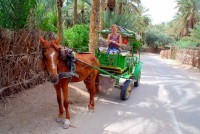

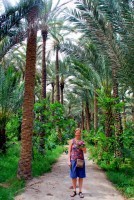
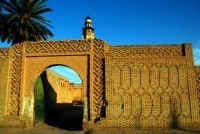
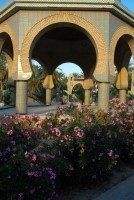
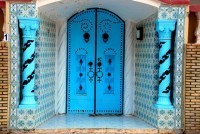
Blog post by Roderick Phillips, author of Weary Heart – a gut-wrenching tale of love and test tubes.
The post Tozeur, Tunisia, Day 269 appeared first on Roderick Phillips.
Tozeur, Tunisia, Day 260
After a brief exploration of Tunis, Christi and I are back on the trains today, and this time we’re riding the Tunisian rail network just about as far as you can go: from Tunis on the Mediterranean coast to Tozeur on the edge of the Sahara desert. Yet again we treat ourselves to a first-class ticket, but as the cost is only US$17 pp, it is well within budget. Train travel is clearly popular because the carriages are packed. Having said that all we see are locals, there are no tourists and no backpackers in sight. This appears to be a feature of Morocco, Tunisia (and from previous experience) Egypt. Most tourists arrive on organized tours and they all travel in private air-conditioned coaches. Backpackers are a rarity, which is good and bad. The good part is that like today we are the only foreigners on the train. The bad part is that very few backpacker facilities exist.
Initially the train follows the coast south to the regional capital of Sousse. At this point the train does an odd thing: it reverses out of Sousse station and continues going ‘backwards’ for the remaining 6 hours of the journey. Further south is the town of Sfax, which is surrounded by olive orchards. In ancient times olive oil production hereabouts (and later sold to Rome) brought huge wealth to the region. Beyond Sfax, we head inland leaving the fertile plains around the coast behind and exchanging them for desert terrain. As we travel deeper into the desert we go, the crowd aboard the train thins appreciably. It’s a very pleasant journey, although once again the locals try to rip us off. This time it’s the guy running the trolley car. It’s only later during the journey that I realize the guy has charged me three times the usual cost for a sandwich and drink. When I confront him he backs down immediately and looks particularly uncomfortable as he returns my money. Unbelievable.
Tozeur train station is virtually deserted and Christi and I have no idea where to go. Fortunately a lone taxi appears out of the dust and takes us to our chosen hotel, the Residence Warda. Here we organize a rather special tour for tomorrow, but for the moment we use the little time left to us to explore this large oasis town. And there are no end of caleche (horse-drawn carriage) drivers willing to show you around. We succumb to temptation eventually (well it’s easier than saying no all the time). The palmeraie in Tozeur is massive and has been in existence for more than 900 years. Most of it has been sectioned off and ownership has historically been passed from one generation to the next. This is changing now, though as both large hotels and wealthy individuals are buying up and developing parcels of land. Our caleche driver engages in a little trespassing as he shows us what is hidden behind the tall fences. Not only are there palm trees, but stands of pomegranate, grape, and apricots. Vegetables (onions, courgettes, lettuce and tomatoes), roses and brightly colored bougainvillea also add to the fecundity on display. An intricate irrigation system was developed centuries ago to ensure the palm trees and other plants received sufficient water.
Water is of course a major challenge in Tunisia as the country attempts to cope with climate change. The government even has a mascot to support environmental conservation. It’s name is Labib and he is a desert fox. Statues of this character are found all over Tunisia (at least they were prior to the Arab Spring) and there is one in Tozeur. Dressed in a blue jumpsuit and armed with a purse, this long-eared character is an odd-looking advocate for environmental causes. Perhaps this is why he was done away with in the post-Arab Spring world. We finish yet another busy day in the Old City, and while the intricate geometric patterns and yellow/brown brickwork facades on the walls and houses look impressive, they also look as if they were built yesterday.
In anticipation of an unforgettable day tomorrow, I go to bed dreaming of a galaxy far, far away.






Blog post by Roderick Phillips, author of Weary Heart – a gut-wrenching tale of love and test tubes.
The post Tozeur, Tunisia, Day 260 appeared first on Roderick Phillips.
April 23, 2014
Sidi Bou Said, Tunisia, Day 268
Damn our bed at the Grand Hotel de France is comfortable. So much so in fact that despite our limited time in Tunis, neither Christi nor I have much inclination to get up. When we do finally surface we have to reassess our plans for the day. Out goes a visit to the ruins of Carthage, which lie in the suburbs of present day Tunis. It was the Carthaginian general, Hannibal, if you recall, who famously took elephants over the Alps to attack Northern Italy and the Roman Empire in 219 BC.
Our goal for today is rather more modest: a visit to the cliff top village of Sidi Bou Said, some 20 km east of Tunis, which we achieve without the use of elephants. Instead, we let the train take the strain, although we board the TGM commuter train a little warily after our unpleasant experience on the metro yesterday. Fortunately, the atmosphere is much more relaxed and we enjoy an easy 35-minute ride alongside Lake Tunis and through the suburb of Carthage (which has 6 stations, including Carthage Hannibal), before reaching the scenic splendor of Sidi Bou Said.
Overlooking the beautiful aquamarine waters of the Mediterranean Sea from its perch on an escarpment, Sidi Bou Said appears to be a mixture of small village with a traditional lifestyle and a rich private retreat for Tunis’s wealthy commuters. Superimposed on this is the tourist industry and while we were exploring wave after wave of tourist buses flooded the village with nationalities the world over. On the one hand it’s nice to be so cosseted: no concerns other than what souvenirs to buy or what clothes to wear. On the other, the tourists are herded and controlled like any other merchandise. Retail opportunities are of course boundless, bright, and colorful, but so obviously tourist kitsch that we resist the temptation to buy anything easily.
Much like Chefchaouen, Sidi Bou Said is largely painted in a palette of cerulean blue and white. And much like Chefchaouen, Sidi Bou Said is clean and well maintained (adding to it’s eye-catching appeal), while the abundant bougainvillea gives the place an extra splash of color. It’s no surprise Sidi Bou Said is so popular. Christi and I get off the beaten track and explore some of the back streets and these are equally pretty, especially the intricately designed doors. Eat a very expensive late lunch at Cafe Sidi Chebaane, which has spectacular views overlooking Sidi Bou Said harbor. The harbour is packed with pleasure boats and beyond that are the exquisite aquamarine waters of the Mediterranean Sea. After a lazy lunch we amble back to the train station. Luckily there is a train getting ready to leave and we we hop aboard for the short journey back to town. Our room at the Grand Hotel de France may not be quite so aesthetically appealing as Sidi Bou Said, but it has the same warm and welcoming feel – and that shower is divine. This is the first time Christi and I have been truly clean since we arrived in Africa almost 3 months ago.
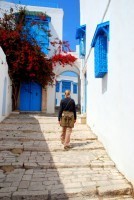
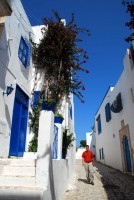
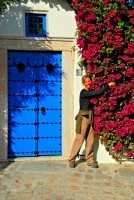
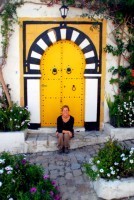
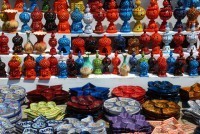
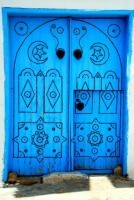
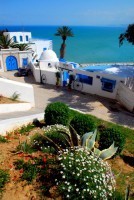
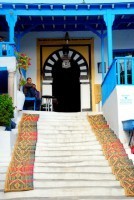
Blog post by Roderick Phillips, author of Weary Heart – a gut-wrenching tale of love and test tubes.
The post Sidi Bou Said, Tunisia, Day 268 appeared first on Roderick Phillips.
Sidi Bou Said, Tunisia, Day 259
Damn our bed at the Grand Hotel de France is comfortable. So much so in fact that despite our limited time in Tunis, neither Christi nor I have much inclination to get up. When we do finally surface we have to reassess our plans for the day. Out goes a visit to the ruins of Carthage, which lie in the suburbs of present day Tunis. It was the Carthaginian general, Hannibal, if you recall, who famously took elephants over the Alps to attack Northern Italy and the Roman Empire in 219 BC.
Our goal for today is rather more modest: a visit to the cliff top village of Sidi Bou Said, some 20 km east of Tunis, which we achieve without the use of elephants. Instead, we let the train take the strain, although we board the TGM commuter train a little warily after our unpleasant experience on the metro yesterday. Fortunately, the atmosphere is much more relaxed and we enjoy an easy 35-minute ride alongside Lake Tunis and through the suburb of Carthage (which has 6 stations, including Carthage Hannibal), before reaching the scenic splendor of Sidi Bou Said.
Overlooking the beautiful aquamarine waters of the Mediterranean Sea from its perch on an escarpment, Sidi Bou Said appears to be a mixture of small village with a traditional lifestyle and a rich private retreat for Tunis’s wealthy commuters. Superimposed on this is the tourist industry and while we were exploring wave after wave of tourist buses flooded the village with nationalities the world over. On the one hand it’s nice to be so cosseted: no concerns other than what souvenirs to buy or what clothes to wear. On the other, the tourists are herded and controlled like any other merchandise. Retail opportunities are of course boundless, bright, and colorful, but so obviously tourist kitsch that we resist the temptation to buy anything easily.
Much like Chefchaouen, Sidi Bou Said is largely painted in a palette of cerulean blue and white. And much like Chefchaouen, Sidi Bou Said is clean and well maintained (adding to it’s eye-catching appeal), while the abundant bougainvillea gives the place an extra splash of color. It’s no surprise Sidi Bou Said is so popular. Christi and I get off the beaten track and explore some of the back streets and these are equally pretty, especially the intricately designed doors. Eat a very expensive late lunch at Cafe Sidi Chebaane, which has spectacular views overlooking Sidi Bou Said harbor. The harbour is packed with pleasure boats and beyond that are the exquisite aquamarine waters of the Mediterranean Sea. After a lazy lunch we amble back to the train station. Luckily there is a train getting ready to leave and we we hop aboard for the short journey back to town. Our room at the Grand Hotel de France may not be quite so aesthetically appealing as Sidi Bou Said, but it has the same warm and welcoming feel – and that shower is divine. This is the first time Christi and I have been truly clean since we arrived in Africa almost 3 months ago.








Blog post by Roderick Phillips, author of Weary Heart – a gut-wrenching tale of love and test tubes.
The post Sidi Bou Said, Tunisia, Day 259 appeared first on Roderick Phillips.
April 22, 2014
Bardo Museum, Tunis, Day 267
Our overnight Alitalia flight from Casablanca to Rome is terrible. The attendants are surly, the food is surprisingly poor, and they do not even bother with a safety briefing. More disturbing is the fact that the plane appears to be falling apart. The lights flicker on and off repeatedly throughout the flight, while weird, unexplained noises emanate from the cabin. If the Alitalia flight crew noticed or even cared they didn’t explain the reason to an increasingly jittery group of passengers. On the plus side, Christi and I have a row of three seats to share, which enables us to doze a little during the turbulent 3-hour flight. Add in a 2-hour time difference and it’s 7.30 am when we finally touch down in the Eternal City amid a thunderstorm. But at least we got there and the Icelandic eruptions did not impede our progress. We have a 2-hour layover, and yet we feel so discombobulated by the sudden cultural change. Most everything in Africa is a struggle; in Europe and the West convenience and easy living are taken for granted. No wonder there is a mass migration from Africa to Europe. It’s almost surreal to say it but Christi and I are eager to return to the daily struggles of life in Africa. Our connecting flight to Tunis, capital of Tunisia is a more pleasant 55-minute hop that involves a comforting safety briefing (even if the food remains debatable). This is our third country in 24 hours and we’re exhausted.
Tunis begins poorly as our taxi driver rips us off, charging double the price suggested in our Lonely Planet guide. Perhaps if I wasn’t so tired I would have argued with the guy, but all I really want at the moment is a nap. The Grand Hotel de France is not quite as grand as the title suggest, but at US$25 per night including breakfast it is perfectly adequate. What this hotel does have is the best shower we have experienced so far in Africa. Both Christi and I indulge outrageously, hoping to wash away not only the dirt but our tiredness as well. For reasons that I cannot fathom now, I’ve allowed only 1.5 days to explore Tunis and the clock is ticking. So if we sleep we will see nothing.
After a spicy shawarma lunch (Christi is thrilled by the return of flavorful food) we take metro line 4 to the Bardo Museum – one of the highlights of Tunis according to our trusty Lonely Planet guide to Africa. It costs pennies to ride the train, which probably explains why the entire population of Tunis join us. We are packed in to the point of suffocation and still the Tunisians force their way into the carriages. There’s a frisson of agitation and edginess; the possibility that violence is simmering just beneath the surface. Christi and I both feel uncomfortable – Christi for the unwanted physical attention of the locals, while I’m fearful of being robbed again. Indeed we force our way off the tram and out of the mayhem several stops early; even then some bully boy Tunisian steals the Tunis City map out of Christi’s hand. Perhaps he thought it was money, the bastard. (I can’t say I could have predicted the Arab Spring that began in Tunisia not long after we left, but it was clear there was some underlying social tension) Attempting to find the Bardo museum on foot, without a city map, and under threatening skies proves very challenging. We ask the locals several times and often they have never heard of it – and this is the top museum in their country.
We do find the place eventually, although the palace I was expecting is rather drab on the outside. The artifacts are, however, superlative and would not have been out of place in the British Museum, the Louvre, or the Smithsonian Institute. And for once we are able to truly appreciate a museum in Africa because the Bardo offers an English audio guide (how very civilized). The museum comprises mosaics, sculptures, jewelry, and masks dating back thousands of years, recounting the times of Carthaginian and Roman influences in particular. Aside from the marvelous artifacts, themselves, the interior of the palace comprises some beautiful artwork, notably the carved wooden roof in the Sousse room, Hercules playing with his penis (and why not, I say), and the partial mosaic face of Neptune are my favorites. It’s possible that I’m hallucinating due to lack of sleep but the Punic death masks remind me of Orcs from Lord of the Rings, while the Punic goddess, Tanit, is surely Jar Jar Binks from Star Wars!
Later taxi back to our hotel without being ripped off this time (thank you) and collapse into a comfortable bed with fresh sheets and warm blankets by 6.30 pm. With my eyes closed, I could almost be in my own bed at home.
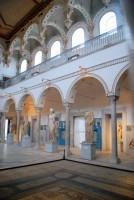
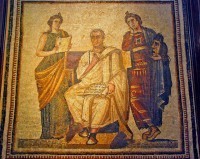
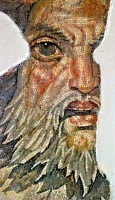
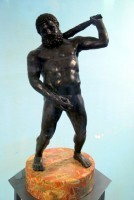
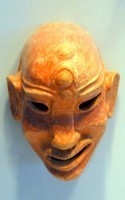
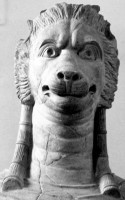
Blog post by Roderick Phillips, author of Weary Heart – a gut-wrenching tale of love and test tubes
The post Bardo Museum, Tunis, Day 267 appeared first on Roderick Phillips.
Bardo Museum, Tunis, Day 258
Our overnight Alitalia flight from Casablanca to Rome is terrible. The attendants are surly, the food is surprisingly poor, and they do not even bother with a safety briefing. More disturbing is the fact that the plane appears to be falling apart. The lights flicker on and off repeatedly throughout the flight, while weird, unexplained noises emanate from the cabin. If the Alitalia flight crew noticed or even cared they didn’t explain the reason to an increasingly jittery group of passengers. On the plus side, Christi and I have a row of three seats to share, which enables us to doze a little during the turbulent 3-hour flight. Add in a 2-hour time difference and it’s 7.30 am when we finally touch down in the Eternal City amid a thunderstorm. But at least we got there and the Icelandic eruptions did not impede our progress. We have a 2-hour layover, and yet we feel so discombobulated by the sudden cultural change. Most everything in Africa is a struggle; in Europe and the West convenience and easy living are taken for granted. No wonder there is a mass migration from Africa to Europe. It’s almost surreal to say it but Christi and I are eager to return to the daily struggles of life in Africa. Our connecting flight to Tunis, capital of Tunisia is a more pleasant 55-minute hop that involves a comforting safety briefing (even if the food remains debatable). This is our third country in 24 hours and we’re exhausted.
Tunis begins poorly as our taxi driver rips us off, charging double the price suggested in our Lonely Planet guide. Perhaps if I wasn’t so tired I would have argued with the guy, but all I really want at the moment is a nap. The Grand Hotel de France is not quite as grand as the title suggest, but at US$25 per night including breakfast it is perfectly adequate. What this hotel does have is the best shower we have experienced so far in Africa. Both Christi and I indulge outrageously, hoping to wash away not only the dirt but our tiredness as well. For reasons that I cannot fathom now, I’ve allowed only 1.5 days to explore Tunis and the clock is ticking. So if we sleep we will see nothing.
After a spicy shawarma lunch (Christi is thrilled by the return of flavorful food) we take metro line 4 to the Bardo Museum – one of the highlights of Tunis according to our trusty Lonely Planet guide to Africa. It costs pennies to ride the train, which probably explains why the entire population of Tunis join us. We are packed in to the point of suffocation and still the Tunisians force their way into the carriages. There’s a frisson of agitation and edginess; the possibility that violence is simmering just beneath the surface. Christi and I both feel uncomfortable – Christi for the unwanted physical attention of the locals, while I’m fearful of being robbed again. Indeed we force our way off the tram and out of the mayhem several stops early; even then some bully boy Tunisian steals the Tunis City map out of Christi’s hand. Perhaps he thought it was money, the bastard. (I can’t say I could have predicted the Arab Spring that began in Tunisia not long after we left, but it was clear there was some underlying social tension) Attempting to find the Bardo museum on foot, without a city map, and under threatening skies proves very challenging. We ask the locals several times and often they have never heard of it – and this is the top museum in their country.
We do find the place eventually, although the palace I was expecting is rather drab on the outside. The artifacts are, however, superlative and would not have been out of place in the British Museum, the Louvre, or the Smithsonian Institute. And for once we are able to truly appreciate a museum in Africa because the Bardo offers an English audio guide (how very civilized). The museum comprises mosaics, sculptures, jewelry, and masks dating back thousands of years, recounting the times of Carthaginian and Roman influences in particular. Aside from the marvelous artifacts, themselves, the interior of the palace comprises some beautiful artwork, notably the carved wooden roof in the Sousse room, Hercules playing with his penis (and why not, I say), and the partial mosaic face of Neptune are my favorites. It’s possible that I’m hallucinating due to lack of sleep but the Punic death masks remind me of Orcs from Lord of the Rings, while the Punic goddess, Tanit, is surely Jar Jar Binks from Star Wars!
Later taxi back to our hotel without being ripped off this time (thank you) and collapse into a comfortable bed with fresh sheets and warm blankets by 6.30 pm. With my eyes closed, I could almost be in my own bed at home.






Blog post by Roderick Phillips, author of Weary Heart – a gut-wrenching tale of love and test tubes
The post Bardo Museum, Tunis, Day 258 appeared first on Roderick Phillips.
April 21, 2014
Hassan II mosque, Casablanca, Day 266
Whereas Rabat is the administrative and political capital of Morocco, Casablanca is undeniably the country’s cultural and economic heartbeat. Having said that, Casablanca is not a tourist hotspot and until relatively recently it lacked an iconic landmark. Perhaps this is what inspired the late king, Hassan II, to build the gargantuan Hassan II mosque between 1980 and 1993. The mosque is located on a rocky promontory of reclaimed land overlooking the ocean northwest of the downtown area, echoing (according to the Lonely Planet) a verse from the Quran that states that God’s throne was built upon the water The statistics are just mind-boggling: the mosque can accommodate 25,000 worshippers inside and a further 80,000 in the surrounding courtyards and squares; the minaret reaches a staggering 210m in height, making it the tallest building in Morocco and the tallest minaret in the world. The Hassan II mosque is the third largest mosque in the world and dominates the skyline over the surrounding low-rise shantytowns. Again, according to our LP guide, the prayer hall is large enough to house Paris’ Notre Dame cathedral or Rome’s St. Peter’s basilica.
Naturally a building this size and one that is decorated with such exquisite tile work, wood carvings, and stucco moulding didn’t come cheap. The Hassan II mosque cost as much as US$800 million to build, raised largely from public subscription although the subscription was not voluntary. Critics argue that if the Moroccan people were forced to contribute so much money, then perhaps it should have been spent on the slums surrounding the mosque and the people who live there under desperate conditions. The criticism is more of a whisper than fully fledged anger as most Moroccans appear pleased with the mighty edifice, although maintaining such a magnificent building in the teeth of the Atlantic is an expensive business. This might explain why the Hassan II mosque is one of only two in the country that allows non-Muslims to visit – for a price. And it ain’t cheap: 120D (US$15) per person. Christi and I pass on the opportunity to explore within, although apparently the interior is the equal of the exterior. Part of the mosque’s floor is made of glass so worshippers can kneel directly over the sea. Unfortunately, this wonderful feature is mainly for royal use and is off-limits to visitors. Also an automated sliding roof opens to the heavens on special occasions. Thus the faithful of Casablanca can indeed contemplate God’s sky and ocean in accordance with king Hassan’s wishes.
We contemplate the meaning of all this at a nearby McDonald’s. Once Christi had seen the Golden Arches there was no stopping her. Clearly she has been brainwashed by this strange cult led by an enigmatic figure known only as Ronald. And on that note it’s time to leave Casablanca and Morocco. Tomorrow is a new day and there will be a new country to explore.
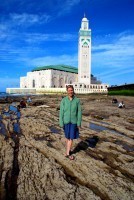
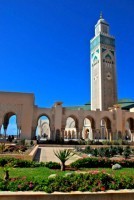
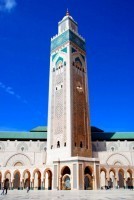
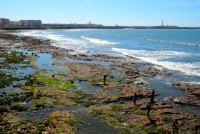
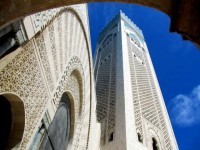
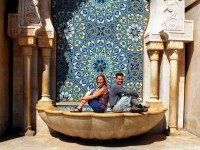
Blog post by Roderick Phillips, author of Weary Heart – a gut-wrenching tale of love and test tubes.
The post Hassan II mosque, Casablanca, Day 266 appeared first on Roderick Phillips.

